Chicago, IL – A young girl laughs as her father steadies her on the concrete in front of a 9/11 memorial. The white cubes and steel beam tower above them, a reminder of nearly 3,000 lives lost in the attacks. Around them, commuters walk past on their way to lunch or errands, glancing briefly but not stopping. The monument has become part of the scenery.
According to the National September 11 Memorial & Museum, more than 700 communities across the U.S. now display artifacts from Ground Zero. These fragments — beams, glass, and stone — were distributed after the attacks and today stand as local reminders of a national tragedy. Each carries symbolic weight, but over time, that weight can be dulled by repetition.
Sociologists note a paradox at the heart of public memory: constant exposure leads to quiet acceptance. At first, memorials are raw, powerful symbols of collective grief. Families gather, officials speak, and ceremonies draw crowds. But as years pass, daily familiarity softens their impact. The crowds dwindle. What was once a place of solemn reflection becoming a backdrop for everyday life — a shortcut to work, a landmark for directions, even a playground edge for children.
The same pattern has played out before. By the 1990s, Pearl Harbor ceremonies still carried power, but the attack itself had shifted in the public imagination. It was history more than memory, with only surviving veterans able to bridge the distance. Today, 9/11 stands at that same crossroads.
For survivors and families, the pain has never expired. But for the wider public, remembrance often takes the form of ritualized gestures: a social post on September 11, a brief pause at a local ceremony, or a passing glance at a memorial walked by a hundred times before. Psychologists call this performative repetition, where symbolic acts preserve memory but drain it of its emotional urgency.
This reveals an uncomfortable truth. While the value of each life lost does not diminish, American consciousness often treats memory as if it does. Recency bias directs attention to newer tragedies — school shootings, wars abroad, natural disasters — leaving older wounds to fade in the national conscience.
Still, the memorials remain. Whether in Honolulu, where the USS Arizona rests, or in Midwestern towns where a beam from Ground Zero rises against the sky, these places resist forgetting. They remind the passerby — even if only for a flicker — that the laughter of a child in front of the monument is possible because others never came home.
The challenge is not simply to “Never Forget,” but to remember deeply. If memorials are to mean more than stone, steel, and repetition, they must ask something of us: reflection, respect, and the recognition that lives do not lose value with time, even if our collective attention moves on.





